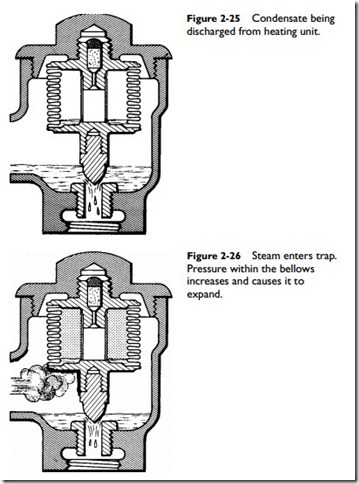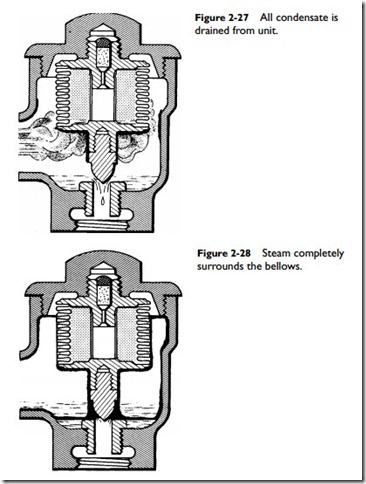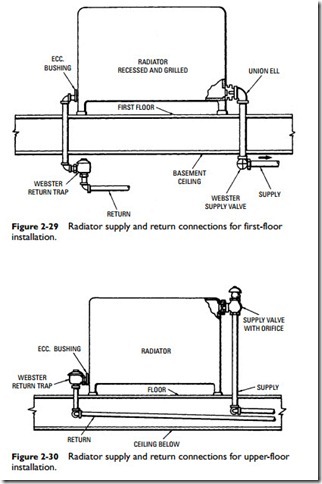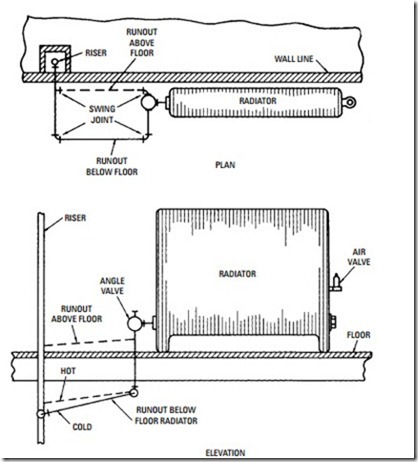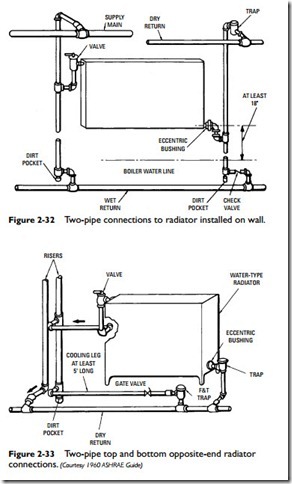Radiator Piping Connections
Some typical radiator piping connections are shown in Figures , 2-30, 2-31, 2-32, and 2-33. The important thing to remember when connecting a radiator is to allow for movement of the risers
and runouts. This movement is caused by the expansion and con- traction resulting from temperature changes in the piping.
Vents and Venting
Each volume of water contains a small percentage of air at atmospheric pressure mechanically mixed with it. This air is liberated
during vaporization and causes some problems for the circulation of steam in the system. As steam starts to fill a heating system, it can enter the radiators, convectors, or baseboard units only as fast as the air escapes. For this reason, some means must be provided to vent this air from the system.
• Hot-water (hydronic) system radiators. The air vent is located at the top of the radiator on the side opposite the inlet (supply) pipe.
• Steam system radiators. No air valve is required for a radiator in a two-pipe steam heating system. In a one-pipe steam sys- tem, the radiator should have an air valve (vent) installed halfway down on the side opposite the inlet pipe.
Adjustable air valves are often found in systems fired by automatic oil or gas burners. This type of air valve permits the adjustment of radiators varying in size and/or distance from the furnace or boiler so that radiators heat at an equal rate.
Nonadjustable air valves are not recommended because the larger radiators will still contain air after the smaller ones have been completely vented. The same problem occurs with the last radiator on a long main. Often the air valve on this radiator does not have enough time to rid the system of air before the on period is completed and the thermostat shuts off the burner. One method of handling this problem is by installing a large-size quick vent at the end of the long main (see Figure 2-34).
Double- or triple-venting is an extreme method of solving the problem of a persistently cold radiator (see Figure 2-35). There is usually only one opening for an air valve on a radiator. A second opening can be added by using a 1⁄8-inch pipe tap and a drill of the proper size.
If a multiple-valve arrangement for a radiator fails to produce the desired results, the only other possibility is to lengthen the burner on period. This can be accomplished on oil burners by altering the differential.
Air must also be vented from hot-water heating systems. Trapped air will cause these systems to operate unsatisfactorily, and a means
should be provided to eliminate it. Manually operated air valves located at the highest levels in the heating system and automatic air valves placed at critical points will usually vent most of the trapped air.
Steam Traps
Steam enters the top of the radiator in a two-pipe steam heating system. As the steam moves through the radiator, a portion of it condenses and the water drips down to the bottom of the unit where it exits through a condensate pipe. In the two-pipe system, a steam trap is installed where the condensate pipe is connected to the radiator. The function of the steam trap is to remove the water (condensate) and prevent any steam from escaping the radiator and entering the condensate return lines. Additional information about steam traps can be found in Chapter 10 (“Steam and Hydronic Line Controls”) of Volume 2.
Not all radiators in two-pipe steam heating systems use steam traps to prevent the steam from entering the condensate return lines. Some are equipped with a small check valve, an internal opening, or a seal.
